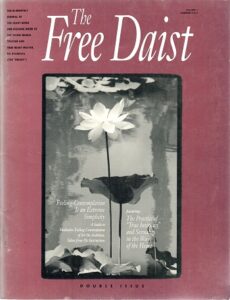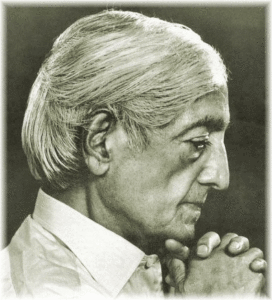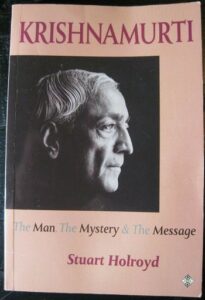Originally published in ‘The Free Daist’
The Bi-Monthy Journal of Th Heart-Word and Blessing Work of The Divine World-Teacher and True Heart-Master, Avabhasa (The “Bright”)

In September 1991, Sri Gurudev received the book Krishnamurti: The Man, the Mystery, and the Message, by Stuart Holroyd. (J. Krishnamurti lived from 1895 to 1986.) Sri Da Avabhasa Reviewed and then partially re-Wrote His Essays in The Basket of Tolerance on the subject of Krishnamurti’s Teaching, and then Wrote the following additional Essay.
♦ ♦ ♦
 J Krishnamurti was a longtime popular religious (or philosophical) lecturer whose glamorous early-life association with the Theosophical movement (whose messianic claims about him he only eventually disavowed) provided him with a lifelong charismatic mystique that his philosophy itself would never have deserved or aroused. Thus, J. Krishnamurti was, throughout his long adult life, popularly presumed to be a somehow Divinely (or Inherently Perfectly) Enlightened figure, whereas, in fact, he was a person of limited religious and Spiritual experience who was perpetually preoccupied with the reactive tendencies and the time-bound nature of his ordinary thinking mind.
J Krishnamurti was a longtime popular religious (or philosophical) lecturer whose glamorous early-life association with the Theosophical movement (whose messianic claims about him he only eventually disavowed) provided him with a lifelong charismatic mystique that his philosophy itself would never have deserved or aroused. Thus, J. Krishnamurti was, throughout his long adult life, popularly presumed to be a somehow Divinely (or Inherently Perfectly) Enlightened figure, whereas, in fact, he was a person of limited religious and Spiritual experience who was perpetually preoccupied with the reactive tendencies and the time-bound nature of his ordinary thinking mind.
Indeed, J. Krishnamurti was characteristically (and rather constantly) involved with concerns relative to the limitations inherent in the third stage of life. Thus, his personal struggle was principally concerned with emotional reactivity, the thinking mind, and the will. And the philosophy he promoted is basically a psychological argument relative to the quieting (or practical undermining) of emotional reactivity, thought, and willfulness. However, even though J. Krishnamurti’s arguments (and meditations) served (in his own case, and, potentially, in the case of some others) to (at least occasionally and temporarily) release (or de-condi-tion) emotion, mind, and will, the result of the exercise was not, and could not be, Divine (or Inherently Perfect) Enlightenment.
J. Krishnamurti’s adult philosophical views were, at their point of origin, the product of an adolescent (or generally third stage) crisis of disillusionment (relative to the mythical “Masters” and the popular mystical and occult Teachings of the Theosophical movement) and desperate sorrow (relative to the early and sudden death of his brother Nitya, who was his heart-intimate companion in the Theosophical enterprise). That disillusionment and desperate sorrow became the foundation mood of J. Krishnamurti’s entire adult life, and, as an adult, he appeared to be constantly occupied with the struggle to understand and transcend the fact and the implications of an essentially disillusioned (or faithless) and desperately sorrowful (or lonely) state of emotion, mind, and will. In the lifelong context of that constant struggle, J. Krishnamurti achieved a characteristic psychological and philosophical resolution, which he described with such words as “aloneness” (released of loneliness) and “choiceless awareness” (released of thought and willfulness). Indeed, even though he (especially early in his life) had some rather rudimentary mystical experiences and limited Yogic experiences, J. Krishnamurti’s achievement (or resolution) was not Divine (or Inherently Perfect) Enlightenment, and not even any fully advanced (or otherwise ultimate) degree of Spiritual Realization (or God-Realization), but it was a simple psychological state (of quiescent emotion, mind, and will), marked by a heightened physical and sensory openness (and sensitivity) to the etheric energy and perceptual phenomena of the natural world.
J. Krishnamurti’s “Realization” (or popularly presumed “Enlightenment”) was, basically, a psychological and philosophical resolution of the developmental crisis that characterizes the third stage of life. He was, because of the limitations posed by his rather reactive temperament, disinclined toward the further enterprise of fully entering, and fully passing through and beyond, the developmental processes of the fourth, the fifth, and the sixth stages of life, and, thereby, ultimately, of entering the seventh (or truly Divinely, and Spiritually, Enlightened) stage of life. Therefore, J. Krishnamurti’s achievement, and his cultural (or philosophical) contribution to human society, although it may be of use as a meditation on psychological self-healing, is limited to the developmental concerns of the third stage of life. And, thus, rather than providing insight and example relative to the matter of Ultimate (or Inherent, and Inherently Perfect) ego-transcendence and Ultimate (or Inherently egoless and Inherently Perfect) Enlightenment (or truly Most Perfect Divine and Spiritual Realization), J. Krishnamurti’s resolution was (and is, for anyone who achieves it) merely another (and even rather early) stage in the development of the ego itself.
The ego-T is not an entity. The ego-T is an activity. It is the activity of self-contraction, enacted by the body-mind (as a whole, and in its every part or function). And the principal (or foundation) characteristics (or results) of egoity are the presumptions of separateness, separativeness, “difference”, and apparent relatedness (between a separate self and its objects). J. Krishnamurti’s enterprise was a struggle to overcome emotional reactivity, thought, and willfulness. As such he was an urgent participant in the effort to resolve the conflicts inherent in the third stage of life, which stage is itself an early stage of the development (or psycho-biography) of the ego. Thus, his resolution, although psychologically clarifying (and psycho-physically healing), was merely the achievement of an advanced (but not yet complete) level of third stage maturity. He felt released and healed by his psychological and philosophical resolution, but he also remained psychologically and philosophically unable to proceed from there to the true and full embrace of the fourth stage of life, and, via the fourth stage of life, to the true and full embrace of the developmental stages beyond the fourth stage of life.
J. Krishnamurti’s resolution (achieved to one or another degree) can rightly be described as a reactionless, thought-free, and motiveless (or non-willful) state of individuated and independent aloneness. However healing he may have felt that achievement to be in mind and heart and body (including the brain), the state of individuated and independent aloneness (however purified or deconditioned) is not the Inherently Perfect (or Divinely and Spiritually Enlightened) State (Which Is Perfectly, and Non-separately, Single, and, only in that sense, Alone). Indeed, aloneness, conceived and perceived as a state both individuated and independent, is the primal characteristic of egoity itself. Unlike Un-conditional Realization of the Inherently Non-separate Singleness of the Divine Self-Condition, the presumption of individuated and independent aloneness is the presumption of separateness, and the presumption of separateness is itself the result of the activity that is separativeness. Indeed, the presumption of individuated and independent aloneness is, simply, self-contraction. Therefore, at last, J. Krishnamurti’s resolution is (for anyone who achieves it) merely a psychologically much de-conditioned state of egoity. And, even though such a de-conditioned state is functionally preferable to that of an emotionally reactive, hypermental, and willful adolescence, it is not itself the Ultimate Condition (or Inherently Perfect Divine Enlightenment) That Is the True Fulfillment of the religious (and progressively Spiritual) life.
Although J. Krishnamurti’s spoken and written words make constant reference to psychological freedom, and to quietness of mind, and to receptivity (even via the physical brain) to the natural energy that is apparent when thought ceases, and so on—his descriptions of his achieved state are not those of a true and inspired religious ecstatic, nor do his words ever indicate the Realization of the Ultimate and Unqualified Spiritual Bliss (or Inherent, Inherently Perfect, Non-separate, and necessarily Divine Happiness Itself) and the Inherently Perfect Freedom (of Inherent, Inherently Perfect, Nonseparate, and necessarily Divine Being Itself) That necessarily characterize any “one” who has Truly and Fully Realized That Which Is Obvious when self-contraction (or the ego-T) is Inherently, and Inherently Perfectly, transcended.
Finally, after his break with the Theosophical movement, J. Krishnamurti always presented himself as a critic of traditional religion (even in its esoteric and truly Ultimate forms, as well as in its lesser and popular and even false forms). He indiscriminately opposed all forms of traditional religious enterprise, all forms of authority, faith, and worship, all Realizers (or “Gurus”, however great or small in their Realization), and, in short, all of religion, except for his own profession of religious lecturing and his own preferred form of religious exercise (which is essentially a matter of, in his manner, understanding the functional thought-mind, and communing, even via the quieted brain, with the pervasive etheric energy of the natural world). As a critic of religion, J. Krishnamurti was an intolerant and even nasty curmudgeon, and a profoundly uninformed, unsympathetic, and religiously inexperienced iconoclast. Quite simply, as a critic of religion, J. Krishnamurti did not know what he was talking about.
At last, it must be said that J. Krishnamurti never did finally overcome the religious disillusionment and emotional despair of his youth. He remained, even to his death, possessed by his separate and separative aloneness, bereft of any Teacher, Teaching, or Graceful Revelation That could Attract him, Utterly and Perfectly, beyond himself.
♦ ♦ ♦
